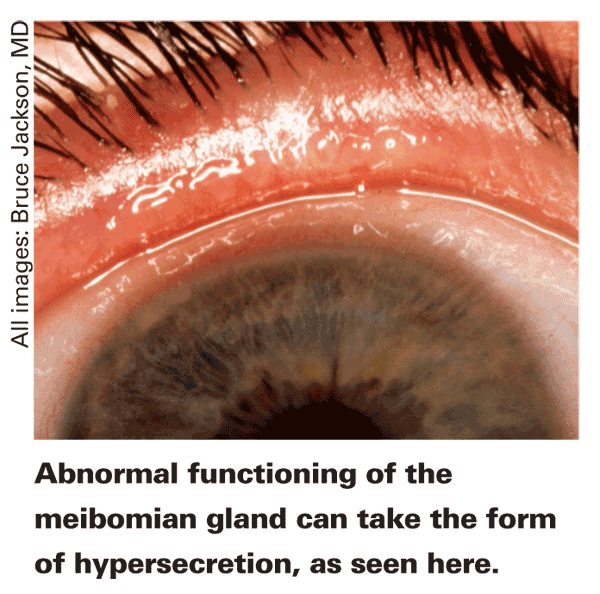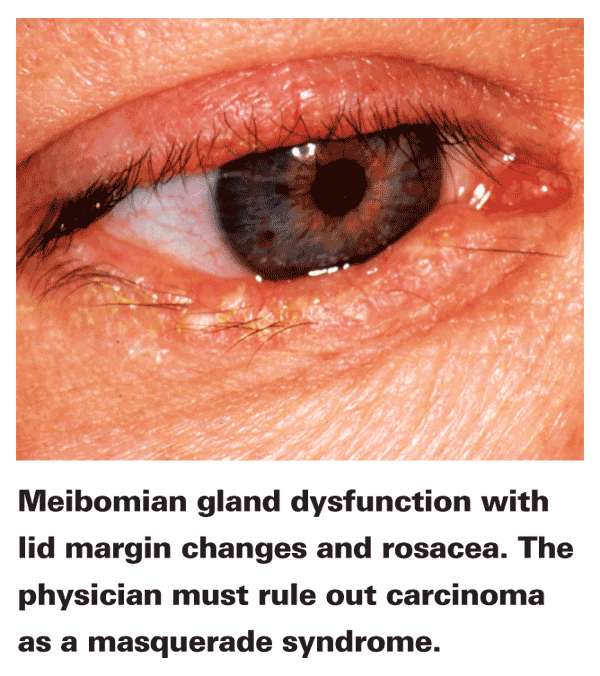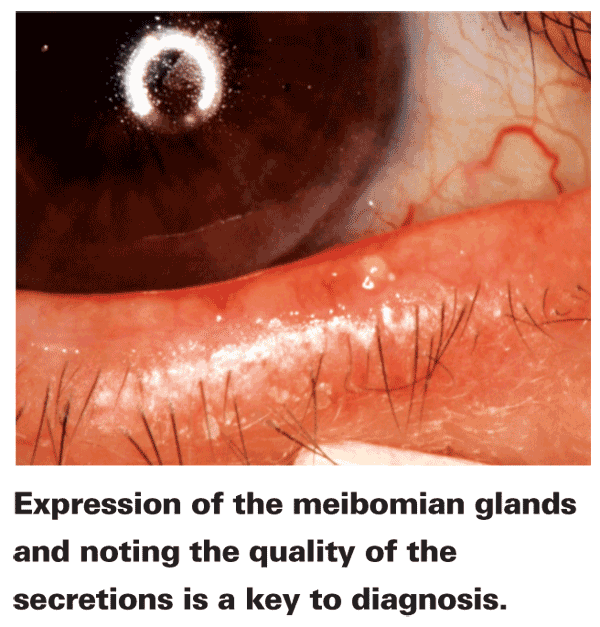When a patient presents with an irritated eye and/or dry-eye symptoms, meibomian gland dysfunction is high on the clinician's differential-diagnosis list. Different from an aqueous-deficient state, MGD can cause dry eye by either hindering the body's ability to produce natural oils that keep tears on the eye, or by altering the quality of the oils so much that they can't do the job properly. In this article, ocular surface experts share their tips for rooting out MGD as the cause of patients' complaints and discuss the treatment approaches that work best.
Classifying MGD
MGD is also sometimes referred to as posterior blepharitis, and
"The traditional division in the classification of dry eye is aqueous-deficient and evaporative," Dr. Tauber continues. "Though there are some causes of evaporative dry eye unrelated to blepharitis, such as anatomical problems with the lids like issues with exposure, the overwhelming cause of evaporative dry eye is related to dysfunction of the meibomian gland. Also, severity escalates from individuals with abnormal secretions from the meibomian gland but no symptoms to individuals with lid problems. There are also those a little further along with problems on the corneal surface that are directly related to the abnormal functioning of the gland and/or problems from the gland's effects on the tear film."
 Ottawa
Ottawa
Diagnostic Signs and Symptoms
Though every ophthalmologist will approach a patient a little differently than his colleagues, here are thoughts to keep in mind from physicians constantly dealing with MGD.
• Symptoms. Physicians say it can be hard to pinpoint MGD from a patient's chief complaint alone. "The symptoms of meibomian gland dysfunction occupy, I find, a wide range," says Robert Latkany, MD, founder of New York Eye and Ear Infirmary's Dry Eye Clinic. "They can be as simple as asymptomatic, or they can be burning—which is high on the list—dryness, irritation, tearing, redness, a foreign body sensation or intermittent blurry vision. Those are the key complaints. However, sometimes there can be pain in the form of a pinprick sensation. So, no one symptom points directly to this condition, though some specialists disagree with that notion."
• Look at the whole patient. The experts note that, in cases of MGD, it can be a mistake to instantly dim the room lights and go to the slit lamp, as that approach can actually make your diagnostic process harder. "Everyone needs to stand back and look at the patient as a whole," says Dr. Jackson. "We should quickly assess such aspects as whether or not he has rosacea or other skin problems around the face, as MGD is associated with rosacea. Rosacea cases are frequently missed, especially when associated with dry eye." It's at this time that you can also notice chalazia. "If the patient has a chalazion you can see or has a history of multiple or recurrent chalazia, that's diagnostic of MGD," says
• The patient's history. It's also important to take a good history, especially with regard to the medications the patient may have taken. "A complete history is of great value," says Dr. Tauber. "In patients with a history of breast cancer, the chemotherapy drug Taxotere is infamous for causing pretty severe meibomian gland dysfunction, in my experience. The same is true for Accutane, not that you can reverse its effects easily.
Still, knowledge of a patient's use of these drugs has prognostic value, as you can tell the patient to buckle up for the long haul in terms of treatment." Dr. Jackson also lists topical antibiotics, especially aminoglycocides, as possible inciting factors behind MGD, due to their possible toxic effects.
 Dr. Latkany tries to get a sense of the diurnal fluctuations in symptoms. "I find that meibomian gland dysfunction is more bothersome for these patients early in the morning or near the end of the day," he says.
Dr. Latkany tries to get a sense of the diurnal fluctuations in symptoms. "I find that meibomian gland dysfunction is more bothersome for these patients early in the morning or near the end of the day," he says.
• Detailed diagnostic tips. If there aren't obvious signs of rosacea or chalazia that help clinch the diagnosis quickly, take a detailed look at the eye. "Look at the quality of the tear film," says Dr. Harris. "Are there oily debris floating in it that could point to MGD?
Also, look at the tear-film breakup time. Sometimes, there's no oily debris in the tear film but a rapid tear breakup that can be a clue that MGD is present. Punctate keratopathy can be a sign of dry eye, MGD or both. And look at the meibomian gland orifices to see if they're present or scarred down by previous inflammation or plugged with a whitish material. Also, you can transilluminate the tarsal plate to look for evidence of atrophy, loss or degeneration of the meibomian glands, all of which would contribute to the diagnosis of MGD."
Doctors say expression of the glands is telling, as well. "The eye exam isn't complete until you look at the lid margin at the slit lamp and express the glands with a cotton-tip applicator or your finger," says Dr. Latkany. "Observe how easily the contents of the meibomian glands come out and note their consistency. In a healthy patient without evidence of blepharitis, a gentle compression of the lid margin will yield a clear, oily substance from the meibomian glands. You don't have to push that hard to get it out.
The harder you have to push, the less likely it's coming out with a natural blink. And, if it's not coming out with a natural blink, chances are the oils aren't serving their purpose.
Use that as your baseline. In patients with meibomian gland dysfunction or posterior blepharitis, it won't be normal. I use a grading system of 0 to 4+ for meibomian gland secretions. 1+ is a slightly thicker and slightly discolored expression, while at 4+ you might not be able to get anything out of a gland. There's also the toothpaste sign in which, if you squeeze hard enough, you get a secretion that has the appearance of toothpaste squeezed from a tube—a white ribbon. That's also on the severe end of meibomian gland dysfunction."
Dr. Latkany also uses the tear-film normalization test on these patients to look for the presence of dry eye, since they often experience intermittent blurry vision. For the test, he checks the patient's vision with the Snellen chart until he gets to a line that looks fuzzy to the patient. At that point, Dr. Latkany instills a drop of watery tears in the patient's eyes, such as a Refresh or a Blink tear. If the line becomes clear within five to 10 seconds, he knows the patient has dry eyes, and, in his experience, it's typically from MGD. "If the vision doesn't improve, his level of dryness isn't that severe, or is possibly non-existent," he says.
Dr. Harris also notes to watch for saponification. "Another indication of meibomian gland dysfunction is foaming in the tear lake consisting of soapy molecules," he says. "Bacterial oxidation has begun to convert the meibomian lipids into soapy molecules in the tear film, which cause the symptoms of irritation patients may complain of." Physicians also say bad atopic patients can have both anterior and posterior blepharitis, and often present with red, puffy eyes.
Treating MGD
When approaching treatment for MGD, the experts usually try the simple treatments first.
• Traditional approaches. "Highest on the list is getting the patient to play an active role expressing his glands on a daily basis, similar to flossing his teeth," says Dr. Latkany. "He can do it at home with a Q-tip. Also, addressing the source of any inflammation is key. If the patient is highly allergic, find out what he's allergic to and avoid it, or have him take some anti-allergy medication. If he has rosacea, identify the triggers and avoid them. If it's a medication issue, see if you can go to an alternative. Anything that triggers inflammation can certainly impact the flow of the meibomian glands."
Dr. Tauber describes his treatment approach to patients with the phrase, "Normalize, mobilize and neutralize." "Ideally, first we would normalize the secretion," Dr. Tauber says. "I think doxycycline and omega-3 supplements are our best strategies to do that at the moment. There's good evidence that systemic tetracyclines like doxycycline, by virtue of their anti-inflammatory effect and the way in which they change the nature of the lipids produced by the meibomian glands, can relieve symptoms.
 "Next, we mobilize," Dr. Tauber says. "This means getting the oils out of the lids where you don't want them and onto the eye where you do want them. We achieve this through the use of lid compresses, which are believed to melt plugs composed of dried secretions blocking the gland orifice; lid hygiene measures and/or the new approach of probing. Finally, we neutralize. By this I mean the use of artificial tears for their rinsing effect in an attempt to balance the ill effects that are caused by the secretions on the ocular surface." For the use of tetracyclines, a common regimen is doxycycline 100 mg b.i.d. for four to six weeks, according to Dr. Latkany, who mainly reserves it for patients with an inflamed facial presentation.
"Next, we mobilize," Dr. Tauber says. "This means getting the oils out of the lids where you don't want them and onto the eye where you do want them. We achieve this through the use of lid compresses, which are believed to melt plugs composed of dried secretions blocking the gland orifice; lid hygiene measures and/or the new approach of probing. Finally, we neutralize. By this I mean the use of artificial tears for their rinsing effect in an attempt to balance the ill effects that are caused by the secretions on the ocular surface." For the use of tetracyclines, a common regimen is doxycycline 100 mg b.i.d. for four to six weeks, according to Dr. Latkany, who mainly reserves it for patients with an inflamed facial presentation.
"Along the same lines as the tetracyclines, azithromycin [AzaSite] is an option," adds Dr. Latkany. "I haven't determined the type of patient for whom it works best, though, since it doesn't work best for every case of MGD. There's no one medication that treats all cases 100 percent of the time. To try it in a patient, I'd use it b.i.d. for five days along the lid margin, and then q.d. for three more weeks. Here, you're trying to attack the posterior blepharitis with the drug's anti-inflammatory properties in what amounts to an off-label use. I'd also potentially use Restasis for addressing dry eye, as I find it's sometimes helpful for patients with posterior blepharitis/MGD. If I am going to use it, I recommend they refrigerate it and use it b.i.d. or t.i.d. indefinitely.
"For patients who aren't responding to day expression or the subsequent medications, we have steroids and non-steroidal anti-inflammatories, which can certainly be beneficial," Dr. Latkany continues. "You have to be cautious if their use becomes chronic, but, as long as you follow them closely, this is an option. If needed, I'll use Alrex or FML b.i.d. or q.d. for a month or so, then reassess the eye. For some of the severe cases, I might go to a stronger steroid if need be, but I never use it more than t.i.d. I'd then reassess the eye and check the pressure, seeing what the response is in a shorter time frame." Dr. Latkany says it's important for patients who are using more viscous drops or thick ointments to wipe those ointments from their eyes each morning, because the accumulation can potentially obstruct the flow of the glands. Dr. Harris notes that the recently introduced drop Systane Balance (Alcon) may be useful in these patients, as well, since it's designed for patients with MGD. Alcon says Systane Balance's LipiTech system works with the drop's other ingredients in an effort to restore the tear film's lipid layer.
• Experimental treatments. Physicians are working with novel therapies for MGD, including gland probing, intense pulsed light and hormone therapies.
Probing consists of anesthetizing the lid, then inserting a thin, stainless steel probe into blocked glands in the hope of unblocking them. It was first proposed by
Another experimental treatment is Intense Pulsed Light, championed by
Finally, some physicians are turning to compounding pharmacies to mix up topical hormone therapies for MGD patients. "For tough cases, you have to think outside the box," says Dr. Latkany. "Hormone therapy can be testosterone or a combination of testosterone and progesterone. Leiter's Compounding Pharmacy in
Though ophthalmologists can successfully treat many MGD patients, they say their understanding of the disease is only just beginning, and they look forward to the upcoming release of the findings of the International Workshop on Meibomian Gland Dysfunction, which are to be published in Investigative Ophthalmology and Visual Science. "With the publishing of the workshop's findings, we're going to find out that there's so much crossover," says Dr. Jackson. "You can have anterior and posterior blepharitis together. Also, we don't yet know the roles of cytokines and chemokines in blepharitis, for example. We're not nearly as far along in our understanding of lid disease as we are in our understanding of dry eye."



